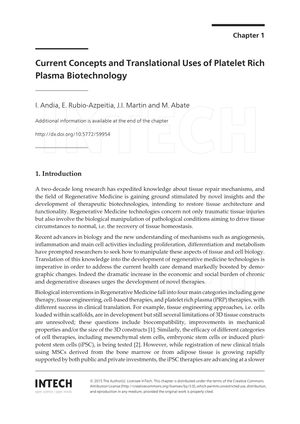Current Concepts and Translational Uses of Platelet-Rich Plasma Biotechnology
April 2015
in “
InTech eBooks
”

TLDR Platelet Rich Plasma (PRP) shows promise for tissue repair and immune response, but more research is needed to fully understand it and optimize its use.
The document from 2015 explores the use of Platelet Rich Plasma (PRP) in regenerative medicine, emphasizing its potential in enhancing tissue repair and its role in modulating immune responses, angiogenesis, and stem cell activation. PRP is an autologous plasma fraction that has been rapidly adopted due to its simplicity and biosafety, but there is a need for more research to understand its biological mechanisms fully. The document also discusses the regulatory landscape for PRP, noting that in the US, PRP administration is not regulated by the FDA, while in the EU, PRP devices must comply with specific directives. Clinical applications of PRP are expanding, with some evidence of efficacy in treating non-healing wounds, androgenetic alopecia, and various orthopedic conditions, though more high-quality studies are needed. PRP has also been used in muscle healing, eye treatments, and other therapeutic areas, but results are mixed and further research is required to optimize PRP formulations and understand its mechanisms in tissue repair.






